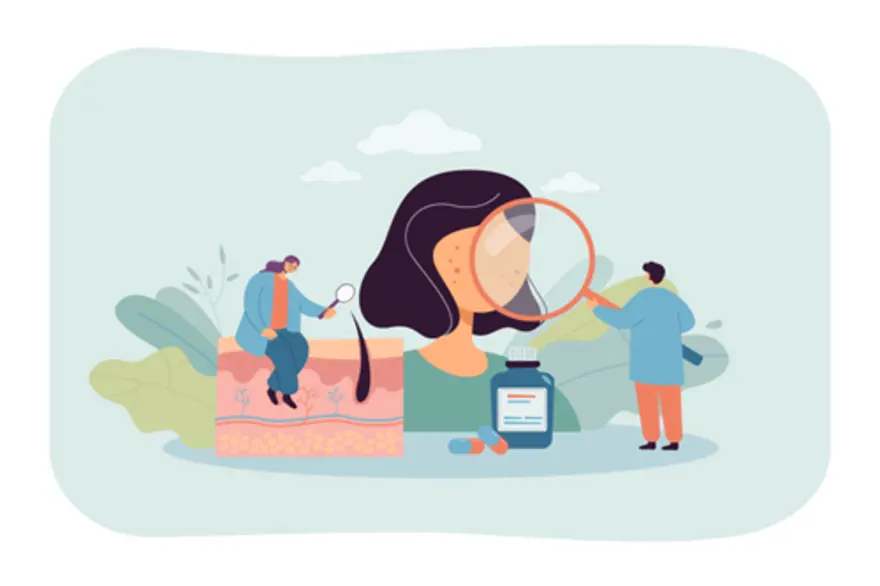Web Stories
Latest Blogs
Truncus Arteriosus: Causes, Symptoms, and Treatment
What is Truncus Arteriosus? Truncus arteriosus is a rare but serious congenital heart defect in which a single large arterial trunk replaces the normal aorta and pulmonary artery. This causes oxygen-rich and oxygen-poor blood to mix before leaving the heart, reducing the amount of oxygen delivered to the body and placing significant strain on the baby’s circulation. Because the condition can quickly lead to heart failure and other severe complications, early diagnosis and prompt treatment are essential. This article outlines the causes, symptoms, diagnosis, treatment options, and long-term outlook to help parents and caregivers understand the condition and what to expect. Truncus Arteriosus vs. Normal Heart Anatomy In a healthy heart, the aorta and pulmonary artery carry blood away from the heart through two separate pathways, ensuring that the body receives oxygen-rich blood while the lungs receive oxygen-poor blood for reoxygenation. These distinct vessels keep circulation efficient and maintain proper oxygen supply. In truncus arteriosus, this process is disrupted because a single large vessel—the truncal artery—leaves the heart and carries mixed blood to the lungs, body, and coronary arteries. A ventricular septal defect (VSD) is almost always present, increasing the mixing of oxygen-rich and oxygen-poor blood. As a result, the body receives less oxygen than it needs, leading to the early symptoms often seen in the first weeks of life. Truncus Arteriosus Causes Truncus arteriosus develops during the first eight weeks of pregnancy, when the baby’s heart is forming. Normally, one fetal vessel divides into the aorta and pulmonary artery, but in this condition the separation fails, leaving a single common vessel. Genetic factors, family history, and certain environmental influences—such as infections, medications, or maternal health conditions—may increase the risk, though most cases occur without a clear cause. The condition affects about 1 in 10,000 births, making it rare. It is classified as a critical congenital heart defect because prompt medical treatment is essential for survival and healthy development. How Truncus Arteriosus Affects Blood Flow (Pathophysiology) Understanding how truncus arteriosus disrupts circulation explains why early treatment is critical. In this condition, both ventricles pump blood into a single truncal vessel, causing oxygen-rich and oxygen-poor blood to mix. As a result, the body receives less oxygen, leading to the bluish or grey tint seen in the skin, lips, and nails. Because there is no separate pulmonary artery, too much blood flows to the lungs, increasing pressure in the lung vessels and straining the heart. Blood Flow Pattern Normal Heart Truncus Arteriosus Right ventricle output Pulmonary artery Single truncal vessel Left ventricle output Aorta Single truncal vessel Blood mixing None Complete mixing Lung blood flow Normal pressure Often excessive This abnormal blood flow puts significant strain on the heart chambers and can rapidly lead to heart failure if untreated. Even the coronary arteries receive mixed blood, which may affect the heart’s own function. Truncus Arteriosus Symptoms in Newborns and Infants Recognising the symptoms of truncus arteriosus early helps ensure your baby receives timely medical care. Most signs appear within the first few weeks of life, as the heart struggles to deliver enough oxygen to the body. Symptoms to watch for include: Cyanosis: Bluish or grayish tint to the skin, lips, or nails Rapid or laboured breathing Poor feeding or frequent breaks during feeds Failure to thrive: Slow weight gain or poor growth Excessive fatigue or unusual sleepiness Frequent respiratory infections Signs of heart failure: Swelling in the hands, feet, or face Examination and Imaging Techniques to Diagnose Truncus Arteriosus Diagnosing truncus arteriosus involves specialised tests that assess the heart’s structure and function. Often, an abnormal heart murmur during a routine exam prompts further evaluation. Common diagnostic tests include: Echocardiogram: Detailed images of heart chambers and blood vessels Chest X-ray: Shows heart size and increased lung blood flow ECG: Evaluates heart rhythm and electrical activity Pulse oximetry: Measures blood oxygen levels Cardiac catheterisation: Assesses pressures inside heart chambers Cardiac MRI or CT: Provides detailed imaging of heart structure and vessel connections Truncus arteriosus occurs in about 7 per 100,000 live births, making up less than 1% of all congenital heart defects. According to the National Institutes of Health, without early surgery, over 80% of infants die within the first year, but with timely repair, long-term survival exceeds 80%. Truncus Arteriosus Treatment Treatment for truncus arteriosus requires early surgical repair, usually within the first few months of life. The goal is to create separate pathways so the lungs and body receive properly oxygenated blood. Surgeons close the VSD and use a conduit to connect the right ventricle to the pulmonary arteries, allowing oxygen-poor blood to reach the lungs while the remaining truncal vessel carries oxygen-rich blood to the body. Before surgery, babies may need medications to manage heart failure symptoms, reduce fluid buildup, support heart function, and improve growth. Long-Term Outlook After Truncus Arteriosus Repair The long-term outlook for children after truncus arteriosus repair has improved significantly with advances in surgical techniques and post-operative care. Modern survival rates exceed 85% when surgery is performed early in life at experienced centres. Survival Rates & Reintervention Expectations Most children will need additional procedures as they grow: Conduit replacement: The right ventricle–to–pulmonary artery conduit often needs replacement over time Valve repairs: The truncal valve may require repair or replacement later in life Arrhythmia treatment: Some children develop irregular heart rhythms that need management Timeline Expected Outcomes 5-year survival >85% with early repair Need for reintervention Most patients by adulthood Normal activities Possible with some restrictions Possible Complications if Untreated or Delayed Without surgical repair, truncus arteriosus can cause serious, life-threatening complications: Pulmonary hypertension: Critically high pressure in lung blood vessels Heart failure: The heart can no longer pump effectively Irreversible lung damage: Permanent changes in lung vessels Growth failure: Poor weight gain and delayed development Death in infancy: Most untreated babies do not survive the first year Living with Truncus Arteriosus (Children → Adults) Children who undergo successful truncus arteriosus repair can often lead healthy, active lives with regular cardiology follow-up. Most grow and develop normally, though some may need to avoid strenuous or competitive sports based on their heart function. Dental Care & Endocarditis Precautions Maintaining good dental hygiene is essential for children with repaired truncus arteriosus: Regular dental check-ups to prevent buildup and detect issues early Antibiotics before certain procedures to reduce endocarditis risk Daily brushing and flossing to lower infection risk Prompt treatment of dental problems to avoid complications Nutrition, Growth, and Development After Surgery Many children show better growth and development after successful repair. Feeding difficulties and high energy demands may cause poor weight gain before surgery, but most children catch up afterward with proper nutrition. Working with a paediatric nutritionist can help ensure adequate calories, and some children may need high-calorie formulas or supplements during recovery. Activity & Sports Participation Physical activity is important after truncus arteriosus repair, with some adjustments: Regular exercise supports heart health and overall fitness Cardiologist guidance helps determine safe activity levels Avoid high-impact or extreme sports that may strain the heart Teach children to recognize fatigue and rest when needed Transition to Adult Congenital Heart Care As children grow into adults, their care shifts to specialists in adult congenital heart disease to ensure continuity and expertise. Ongoing monitoring remains essential, as adults may develop conduit issues, arrhythmias, or heart failure. Regular follow-ups help detect and manage these problems early. Truncus Arteriosus and Pregnancy (Preconception Counselling) Women with repaired truncus arteriosus should receive specialised counselling before pregnancy: Pre-pregnancy evaluation to assess heart function and risks Genetic counselling to understand the chance of congenital heart disease in the baby High-risk obstetric care for close monitoring throughout pregnancy Delivery planning ensures a safe birth with appropriate medical support. How to Choose a Surgical Centre Choosing the right surgical centre is crucial for achieving the best results in truncus arteriosus repair. Look for: Extensive experience with complex congenital heart defects, including truncus arteriosus Transparent survival rates and outcomes for this specific surgery A multidisciplinary team of paediatric cardiologists, surgeons, and ICU specialists Comprehensive long-term follow-up programs for continued care Family support services to help you navigate treatment and recovery Questions to Ask Your Care Team Don’t hesitate to ask your care team important questions, such as: What experience do you have with truncus arteriosus repairs? What are your survival and complication rates? How often do children need further surgeries? What long-term care will my child need? What support resources are available for families? How are emergencies or post-surgery complications handled? When to Call the Doctor After Discharge After surgery, seek immediate medical attention if your baby shows: Difficulty or rapid breathing Blue colouring of the lips, skin, or nails Poor feeding or ongoing vomiting Swelling of the hands, feet, or face Fever or signs of infection at the incision site Irregular heartbeats or fainting Conclusion Truncus arteriosus is serious but treatable. With timely surgery and lifelong follow-up in a specialised congenital heart program, most children can grow, learn, and lead active lives. If your cardiologist recommends blood tests, genetic screening, or ongoing monitoring, choosing a reliable lab ensures faster results and confident decision-making throughout your child’s care. Metropolis Healthcare brings together 4000+ tests (including speciality testing) and comprehensive full body checkups, backed by home sample collection through 10,000 touchpoints for quick turnaround and accurate results. Booking is effortless; choose what’s convenient for you: website, call, app, or WhatsApp, and we’ll handle the rest so you can focus on your child’s recovery. FAQs Is truncus arteriosus curable? Surgery corrects the circulation and relieves symptoms, but lifelong follow-up is needed. Conduits and valves may require replacement over time. What is the survival rate after truncus arteriosus surgery? Contemporary series from major centres report ~90–95% survival to hospital discharge; longer-term survival into adulthood is common, with variation by patient factors and valve issues. Can truncus arteriosus be detected before birth? Yes. Many cases are suspected on prenatal ultrasound and confirmed by fetal echocardiography, which helps plan delivery and immediate care. Will my child need more surgeries as they grow? Often yes. As children grow, the RV-to-pulmonary conduit may need catheter-based or surgical replacement. Your team will time these safely. How long is the hospital stay after repair? Stay length varies by age, anatomy, and valve repair needs. Your surgeon will discuss an expected range based on your child’s plan and recovery. Is physical activity safe after truncus arteriosus surgery? Most everyday activities are fine once your cardiologist clears your child. Competitive sports depend on individual heart function and rhythm status. Does truncus arteriosus affect life expectancy? Many patients lead active lives into adulthood. Lifelong ACHD care helps maintain heart health and address conduit/valve issues as they arise. References https://www.ncbi.nlm.nih.gov/books/NBK534774/ https://www.mayoclinic.org/diseases-conditions/truncus-arteriosus/symptoms-causes/syc-20364247 https://my.clevelandclinic.org/health/diseases/14785-truncus-arteriosus https://www.hopkinsmedicine.org/health/conditions-and-diseases/truncus-arteriosus-ta
Polymyositis: Causes, Symptoms, and Treatment
What is Polymyositis? Polymyositis is a rare, chronic autoimmune disease characterised by persistent inflammation of skeletal muscles throughout your body. The polymyositis meaning encompasses "poly" (many) and "myositis" (muscle inflammation), accurately describing how this condition affects multiple muscle groups simultaneously. This inflammatory myopathy predominantly affects adults between 30 and 60 years, with women experiencing higher rates than men. Unlike other muscle disorders, polymyositis specifically targets the proximal muscles—those closest to your trunk, including shoulders, hips, thighs, and upper arms. The condition belongs to a group called idiopathic inflammatory myopathies, where "idiopathic" indicates that the precise polymyositis causes remain unclear to medical researchers. How Does Polymyositis Affect the Body? Polymyositis primarily impacts your proximal muscles, creating a characteristic pattern of weakness that affects daily activities. You might notice difficulty performing routine tasks like climbing stairs, rising from chairs, lifting grocery bags, or reaching overhead shelves. This progressive muscle weakness typically affects both sides of your body symmetrically. The condition can also involve muscles responsible for swallowing, leading to dysphagia — difficulty swallowing that may make eating or drinking challenging or unsafe. Some individuals experience voice changes when throat muscles become affected. In more severe cases, polymyositis can impact respiratory muscles, causing breathing difficulties or reduced lung capacity. Beyond muscle symptoms, polymyositis can affect other body systems. Heart muscle involvement may cause complications such as arrhythmias or, less commonly, heart failure. Interstitial lung disease develops in about 30% of people with polymyositis, leading to breathlessness and reduced exercise tolerance. These systemic effects explain why comprehensive medical evaluation and monitoring remain essential components of polymyositis treatment. Polymyositis Causes The exact polymyositis causes remain incompletely understood, but researchers have identified several contributing factors. The primary mechanism involves autoimmune dysfunction, where your immune system mistakenly targets and attacks healthy muscle fibres, triggering chronic inflammation and tissue damage. Genetic predisposition plays a significant role, with certain HLA (human leukocyte antigen) types increasing susceptibility. Environmental triggers may activate the autoimmune response in genetically vulnerable individuals. Viral infections, including HIV, HTLV-1, and hepatitis C, have been implicated as potential polymyositis causes in some cases. The condition often occurs alongside other autoimmune diseases, suggesting shared underlying mechanisms. Associations with lupus, rheumatoid arthritis, and scleroderma indicate common inflammatory pathways. Symptoms of Polymyositis Recognising polymyositis symptoms early can significantly improve treatment outcomes. The primary manifestations include: Progressive muscle weakness, particularly affecting shoulders, hips, neck, and thighs Muscle pain and tenderness in affected areas Persistent fatigue that doesn't improve with rest Difficulty swallowing (dysphagia), which may cause choking or aspiration Shortness of breath, especially during physical activity Voice changes if throat muscles are involved Muscle wasting (atrophy) in advanced cases Joint pain and morning stiffness Low-grade fever and general malaise Unexplained weight loss Trouble lifting arms overhead or performing overhead activities Difficulty rising from seated positions or climbing stairs Imaging & Diagnostic Tests to Diagnose Polymyositis Accurate diagnosis requires comprehensive testing combining blood tests, imaging studies, and specialised examinations. Your healthcare provider will likely recommend: Blood tests measuring elevated muscle enzymes such as creatine kinase (CK), aldolase, AST, and ALT indicate muscle inflammation and damage CRP test to assess inflammation levels throughout your body ESR automated blood test measuring erythrocyte sedimentation rate as another inflammation marker Autoimmune panels to evaluate for overlapping connective tissue diseases, including rheumatoid factor (RF) and ANA testing Lupus anticoagulant (LAC) testing may be performed when overlap syndromes or antiphospholipid antibodies are suspected Cardiac evaluation through ECG, echocardiogram, or troponin levels helps assess cardiac involvement Lung marker profile test screening for associated interstitial lung disease MRI of affected muscles revealing inflammation, oedema, and structural changes EMG (electromyography) measuring electrical muscle activity and confirming myopathic changes High-resolution CT (HRCT) scans are particularly useful for assessing interstitial lung disease and screening for malignancies Muscle biopsy confirms the diagnosis by showing endomysial inflammation, necrosis, and CD8+ T-cell infiltration Treatment Options for Polymyositis Effective polymyositis treatment requires a comprehensive, multidisciplinary approach tailored to your specific symptoms and disease severity. Treatment goals include reducing inflammation, preserving muscle function, and preventing complications. Medications for Polymyositis Medscape recommends the following medications as part of the standard treatment approach for polymyositis. Corticosteroids (prednisone or prednisolone) are first-line therapy, rapidly reducing muscle inflammation Immunosuppressive agents like methotrexate, azathioprine, or mycophenolate mofetil for steroid-sparing effects Intravenous immunoglobulin (IVIG) for severe or treatment-resistant cases Biologic therapies such as rituximab may be used in refractory cases unresponsive to conventional immunosuppressants Antimalarial drugs like hydroxychloroquine are useful only when polymyositis overlaps with dermatomyositis or cutaneous manifestations Physical Therapy for Polymyositis Individualised exercise programmes maintaining muscle strength and flexibility safely Range-of-motion exercises preventing contractures and preserving mobility Occupational therapy supporting independence in daily activities and adaptive strategies Respiratory therapy if breathing muscles are affected by the disease process Speech and swallowing therapy for those experiencing dysphagia or voice changes Lifestyle Changes and Management Balanced, nutritious diet supporting muscle repair and overall health Regular, moderate exercise as tolerated, guided by physiotherapy professionals Adequate rest and energy conservation strategies Stress management techniques including meditation or counselling support Smoking cessation reducing lung complication risks Sun protection if photosensitive skin reactions occur Polymyositis Prognosis The prognosis for polymyositis varies considerably depending on several factors, including age at onset, disease severity, associated complications, and treatment response. Approximately 70-80% of patients respond well to initial corticosteroid treatment, with many achieving functional improvement within 6-12 months. However, long-term remission without medication occurs in only about 20-30% of cases. Most individuals require ongoing immunosuppressive therapy to maintain disease control and prevent relapses. Factors associated with better outcomes include younger age at diagnosis, prompt treatment initiation, and absence of lung or heart involvement. Living with Polymyositis Living with polymyositis requires ongoing medical management, lifestyle adaptations, and strong support systems. Many individuals successfully maintain good quality of life through comprehensive care approaches combining medical treatment, rehabilitation, and self-management strategies. Regular monitoring becomes essential, including periodic blood tests to assess disease activity and medication effects, imaging studies like MRI or CT scan to evaluate treatment response, and screening for complications such as lung disease or cardiac involvement. Polymyositis and Its Connection to Other Conditions Lupus (systemic lupus erythematosus) can coexist with polymyositis in overlap syndromes Rheumatoid arthritis may occur alongside polymyositis as part of mixed connective tissue diseases Scleroderma can overlap with polymyositis, creating scleromyositis with both muscle and skin involvement Lung disease, particularly interstitial lung disease, affects approximately 30% of polymyositis patients Congestive heart failure may develop when polymyositis affects cardiac muscle tissue An increased risk of malignancy exists, particularly within the first 3 years after diagnosis, and is more pronounced in older adults Polymyositis Treatment by Region Healthcare infrastructure differences influence treatment approaches, with some regions emphasising traditional medicine integration alongside conventional polymyositis treatment. In urban Indian centres, patients typically have better access to rheumatology specialists, advanced diagnostic facilities including MRI and EMG testing, and newer biologic therapies. Rural areas may face challenges with specialist availability and advanced diagnostic capabilities, potentially delaying diagnosis and optimal treatment initiation. Conclusion Understanding polymyositis empowers you to recognise symptoms early, seek appropriate medical care, and actively participate in treatment decisions. While this autoimmune condition presents significant challenges, comprehensive polymyositis treatment approaches combining medications, physiotherapy, and lifestyle modifications can dramatically improve outcomes and quality of life. At Metropolis Healthcare, we support your journey towards better health through comprehensive diagnostic services. Our extensive portfolio of over 4,000 tests includes specialised panels for autoimmune conditions, muscle enzyme assessments, and inflammatory markers crucial for polymyositis diagnosis and monitoring. With our convenient home sample collection service spanning 220 laboratoties across India, you can access accurate, reliable testing from the comfort of your home. FAQs What are the early signs of polymyositis? Early polymyositis symptoms typically include gradual, symmetrical muscle weakness affecting the shoulders, hips, and thighs, making climbing stairs or lifting objects increasingly difficult. You may experience muscle pain, persistent fatigue, and sometimes difficulty swallowing. Can polymyositis be cured? Currently, there is no cure for polymyositis, but effective polymyositis treatment can control symptoms, improve muscle strength, and slow disease progression. Many patients achieve significant functional improvement with corticosteroids and immunosuppressive medications. How do you manage polymyositis long-term? Long-term polymyositis management involves continuing immunosuppressive therapy, regular physiotherapy, routine monitoring through blood tests and imaging studies, and lifestyle modifications. Is polymyositis related to any other diseases? Yes, polymyositis frequently associates with other autoimmune conditions including lupus, rheumatoid arthritis, and scleroderma as overlap syndromes. The condition can also involve lung disease, particularly interstitial lung disease, and may increase cancer risk, especially in older adults. Heart involvement leading to congestive heart failure occurs in some cases. What role does diet play in managing polymyositis? While no specific diet cures polymyositis, balanced nutrition rich in protein, antioxidants, and omega-3 fatty acids supports muscle repair and overall health. Adequate protein intake helps preserve muscle mass, while anti-inflammatory foods may complement medical therapy. How effective is physical therapy for polymyositis? Physical therapy plays a crucial role in polymyositis treatment, helping maintain muscle strength, flexibility, and functional capacity. Tailored exercise programmes can slow muscle weakness progression, prevent contractures, and improve quality of life. References https://emedicine.medscape.com/article/335925-treatment?form=fpf https://my.clevelandclinic.org/health/diseases/12053-polymyositis https://www.mayoclinic.org/diseases-conditions/polymyositis/symptoms-causes/syc-2035320 https://www.hopkinsmedicine.org/health/conditions-and-diseases/polymyositis
Traumatic Brain Injury: Causes, Symptoms, and Recovery
Traumatic Brain Injury Overview Traumatic brain injury (TBI) occurs when an external force disrupts normal brain function, creating a cascade of physical and chemical changes within brain tissue. The Indian Head Injury Foundation estimates that over 1.5 million people sustain head and brain injuries annually in India. The impact of TBI extends far beyond the initial injury. Many survivors face long-term challenges including cognitive difficulties, emotional changes, and physical limitations. Research shows that even mild TBI can increase the risk of depression, PTSD, and, in some cases, may be associated with an elevated risk of neurodegenerative diseases such as Alzheimer’s or Parkinson’s disease later in life. What Is Traumatic Brain Injury? A traumatic brain injury (TBI) represents damage to brain tissue caused by an external mechanical force, such as a violent blow, jolt, or penetrating wound to the head. Unlike other injuries that heal predictably, TBI affects the most complex organ in your body, making each case unique in its presentation and recovery trajectory. When your brain experiences trauma, it may bounce or twist inside the skull, stretching and damaging brain cells. This physical disruption creates chemical imbalances that prevent neurons from communicating effectively. The injury site may experience bleeding, swelling, or tissue death, whilst surrounding areas can also be affected by reduced blood flow and oxygen supply. What makes TBI particularly challenging is that traumatic brain injury symptoms may not appear immediately. Some people feel fine initially, only to develop problems hours, days, or even weeks later. This delayed onset explains why medical professionals emphasise careful monitoring after any significant head injury, regardless of how minor it may seem at first. Causes of Traumatic Brain Injury Understanding how TBI occurs helps identify prevention opportunities and risk factors. The causes vary significantly across age groups and circumstances. The most frequently encountered causes of head injury in different populations reveal important patterns: Children under 5: Falls from playground equipment, stairs, or furniture are the most common cause Teenagers and young adults: Sports injuries and motor vehicle accidents dominate this age group Working-age adults: Workplace incidents and traffic collisions are most common Older adults: Falls due to balance problems, medication effects, or environmental hazards Military personnel: Blast injuries from improvised explosive devices (IEDs) can cause unique TBI patterns, including primary blast injuries from pressure waves Common Causes of TBI Falls: Account for nearly half of all TBI cases, particularly affecting young children and older adults Motor vehicle accidents: High-speed collisions create powerful forces that cause the brain to move violently within the skull Sports-related injuries: Contact sports like rugby, boxing, and football pose significant risks for repeated head trauma Violence and assaults: Physical attacks resulting in blows to the head or penetrating injuries Explosive blasts: Military personnel and civilians in conflict zones face unique risks from blast-related TBI Workplace accidents: Construction, manufacturing, and other industrial settings present head injury risks Symptoms of Traumatic Brain Injury Recognising traumatic brain injury symptoms early enables prompt medical attention and better outcomes. TBI symptoms can be grouped into several categories: Physical symptoms: Persistent headaches, dizziness, nausea, vomiting, fatigue, and sensitivity to light or sound Cognitive problems: Difficulty concentrating, memory problems, confusion, and slowed thinking Emotional changes: Irritability, anxiety, depression, mood swings, and personality alterations Sleep disturbances: Insomnia, excessive sleepiness, or disrupted sleep patterns Sensory issues: Blurred vision, ringing in the ears (tinnitus), changes in taste or smell, and sensitivity to light or sound Motor difficulties: Balance problems, poor coordination, weakness, or spasticity depending on the injury site Signs of Mild, Moderate, and Severe TBI The severity classification helps guide traumatic brain injury treatment decisions and predict TBI recovery outcomes: Mild TBI (Concussion): Brief or no loss of consciousness, confusion lasting less than 24 hours, normal brain imaging, symptoms typically resolve within weeks to months Moderate TBI: Loss of consciousness for 30 minutes to 24 hours, confusion lasting days to weeks, abnormal brain imaging may be present, recovery often takes months to years Severe TBI: Loss of consciousness exceeding 24 hours, significant confusion lasting weeks or longer, abnormal brain imaging, often requires intensive rehabilitation and may result in permanent disability Imaging & Diagnostic Tests to Diagnose TBI Modern medical imaging plays a crucial role in evaluating brain injuries and guiding TBI treatment decisions. CT scans are the first-line imaging tool in emergency settings, as they rapidly detect skull fractures, intracranial bleeding, and brain swelling. These scans can be completed within minutes and help doctors determine whether emergency surgery is needed. MRI provides higher-resolution images and is better at detecting subtle injuries such as diffuse axonal injury, microhaemorrhages, and contusions that may be missed on CT. This advanced imaging technique is particularly valuable for identifying diffuse axonal injury, small haemorrhages, and areas of brain tissue damage that may not be visible on CT scans. Functional imaging techniques such as PET or functional MRI (fMRI) are mainly used in research or specialised cases to assess brain metabolism and connectivity. However, the diagnosis of TBI relies heavily on clinical assessment combined with appropriate imaging, as no single test can capture the full extent of brain injury. How is TBI Diagnosed? Healthcare professionals use a comprehensive approach to diagnose TBI, combining multiple assessment tools: Glasgow Coma Scale: A standardised scoring system that evaluates consciousness level, verbal responses, and motor function Neurological examination: Detailed assessment of cognitive function, reflexes, coordination, and sensory responses CT scans: Rapid imaging to detect skull fractures, bleeding, and brain swelling in emergency situations MRI scans: Detailed brain imaging to identify subtle tissue damage and structural abnormalities EEG (Electroencephalogram): Assesses electrical activity and can detect seizures or abnormal brain function, especially when symptoms persist Blood tests: Newer biomarker tests can detect specific proteins released when brain cells are damaged Neuropsychological testing: Comprehensive evaluation of memory, attention, processing speed, and other cognitive functions Recovery and Treatment for TBI The approach to traumatic brain injury treatment varies dramatically based on injury severity and individual patient needs. Mild TBI typically requires rest, symptom monitoring, and gradual return to normal activities under medical supervision. Patients must avoid activities that could result in another head injury while the brain heals. Moderate to severe TBI often requires immediate medical intervention, potentially including surgery to reduce brain swelling, remove blood clots, or repair skull fractures. Following stabilisation, comprehensive rehabilitation becomes the cornerstone of recovery. This multidisciplinary approach addresses the complex challenges that TBI survivors face across multiple domains of functioning. TBI Recovery Process Recovery from TBI is rarely linear or predictable. Some people experience rapid improvement in the first few months, whilst others continue making gains years after their injury. The journey from injury to recovery typically follows several phases: Acute care phase: Emergency stabilisation, medical management, and prevention of secondary complications Inpatient rehabilitation: Intensive therapy focusing on basic functional skills and medical management Outpatient rehabilitation: Continued therapy whilst living at home, addressing specific deficits and goals Community reintegration: Support for returning to work, school, and social activities Long-term management: Ongoing support for chronic symptoms and prevention of complications Family education and support: Training caregivers and family members to provide appropriate assistance Physical Therapy and Rehabilitation Comprehensive traumatic brain injury therapy addresses the wide range of challenges that survivors face. Physical therapy focuses on restoring movement, strength, balance, and coordination. Occupational therapy helps people relearn daily living skills and adapt to any permanent limitations. Speech and language therapy addresses communication problems, swallowing difficulties, and cognitive-communication challenges. Neuropsychological rehabilitation focuses on cognitive deficits such as memory loss, attention difficulties, and executive dysfunction. This specialised therapy uses evidence-based techniques to help the brain develop new strategies for processing information and completing tasks. Mental health support is essential, as depression, anxiety, and post-traumatic stress disorder (PTSD) commonly occur after TBI. Prevention of Traumatic Brain Injury How to Prevent Traumatic Brain Injury? Vehicle safety: Always wear seatbelts, use appropriate car seats for children, never drive under the influence of alcohol or drugs Sports safety: Wear properly fitted helmets and protective equipment, follow safety rules, report head injuries immediately Fall prevention: Remove tripping hazards, improve lighting, install handrails, use non-slip mats in bathrooms Home safety: Secure furniture that could tip over, use safety gates for young children, maintain outdoor walkways Workplace safety: Follow all safety protocols, use required protective equipment, report hazardous conditions Violence prevention: Avoid high-risk situations, seek help for domestic violence, support community safety initiatives Conclusion Understanding TBI empowers you to recognise symptoms, seek appropriate care, and support recovery effectively. Whether you're concerned about prevention, managing symptoms, or supporting a loved one's rehabilitation journey, knowledge remains your most valuable tool. At Metropolis Healthcare, we understand the importance of accurate diagnosis in TBI management. Our comprehensive portfolio of more than 4,000 tests includes advanced diagnostic capabilities that support neurological assessment and monitoring. Through our network of over 220 laboratories and 10,000+ touchpoints across India, we provide convenient at-home sample collection services, ensuring you can access essential diagnostic support when you need it most. FAQs What is a traumatic brain injury? A traumatic brain injury (TBI) is damage to the brain caused by an external force, such as a fall, accident, or blow to the head. TBI can range from a mild concussion to a severe injury, potentially affecting thinking, memory, emotions, behaviour, and physical abilities. How long does recovery from TBI take? Mild TBI usually improves within weeks to months, while moderate to severe cases may require months or years of rehabilitation. Some people continue to make gradual progress long after the injury. Can a person fully recover from TBI? Many people with mild or moderate TBI recover well, but severe injuries may leave lasting effects. Even when full recovery isn’t possible, rehabilitation helps individuals manage symptoms and improve quality of life. What is a mild traumatic brain injury? A mild TBI—often called a concussion—temporarily disrupts brain function. Symptoms like headache, dizziness, or memory issues are common. Most people recover, but proper medical evaluation is important. Can you die from a traumatic brain injury? Yes. Severe TBI can be life-threatening due to brain swelling, intracranial bleeding, or injury to vital brain structures. Quick medical attention greatly improves survival chances. References https://indianheadinjuryfoundation.org/traumatic-brain-injury/ https://www.cdc.gov/traumatic-brain-injury/about/moderate-severe-tbi.html https://www.mayoclinic.org/diseases-conditions/traumatic-brain-injury/symptoms-causes/syc-2037855 https://my.clevelandclinic.org/health/diseases/8874-traumatic-brain-injury
Peeling Skin: Causes, Symptoms, and Effective Treatments
What is Peeling Skin? Peeling skin refers to the unintended loss or shedding of your skin's outer layer. Think of it as a protective barrier that’s been damaged—your body naturally sheds the affected cells to make way for healthy new ones. This process can range from mild flaking to larger sheets of skin coming off. Peeling skin should not be mistaken for Peeling Skin Syndrome (PSS)—a rare group of inherited disorders characterized by painless, spontaneous, and continuous shedding of the stratum corneum, often without significant inflammation or injury. While PSS can be a cause for peeling skin, not all conditions are chronic or require medical evaluation. Causes of Peeling Skin Direct skin damage from sunburn, burns, or excessive friction Infections, including bacterial, fungal, or viral conditions Allergic reactions to medications, skincare products, or environmental allergens Immune-mediated skin disorders such as psoriasis, atopic dermatitis, or autoimmune blistering diseases (e.g., pemphigus, bullous pemphigoid) Genetic conditions like Peeling Skin Syndrome (PSS), which, according to the Genetic and Rare Diseases Center, can begin as early as infancy Cancer treatments, including chemotherapy and radiation Medication side effects from various prescriptions Underlying systemic diseases such as chronic liver failure, kidney disease, or congestive heart failure, which can lead to secondary skin dryness and peeling Common Medical Conditions Leading to Peeling Skin Atopic dermatitis (eczema) causing dry, itchy patches Contact dermatitis from exposure to irritants Psoriasis with its characteristic scaly patches Seborrheic dermatitis, which affects sebum-rich areas such as the scalp, face, and upper trunk Kawasaki disease, a vasculitic syndrome seen primarily in children, which can cause peeling of the fingertips and toes during recovery Stevens–Johnson syndrome, a severe mucocutaneous reaction usually triggered by medications or infections Toxic shock syndrome, a life-threatening bacterial toxin–mediated illness requiring emergency care Environmental Causes of Peeling Skin Sunburn from UV exposure without protection Windburn in harsh weather conditions Extreme temperatures, both hot and cold Prolonged water exposure causing maceration Harsh chemicals in cleaning products or soaps Mechanical trauma from tight clothing or repetitive rubbing Low humidity leading to excessive dryness Symptoms Associated with Peeling Skin Visible flaking or scaling of the skin surface Redness underneath the peeling areas Itching or irritation ranging from mild to severe Dryness and rough texture Occasional blistering, especially with genetic causes Pain if underlying skin becomes exposed Fever or flu-like symptoms in severe cases Examination and Diagnostic Tests to Identify Peeling Skin When you visit a healthcare provider for peeling skin, they'll conduct several assessments: Physical examination of affected areas and distribution patterns Detailed medical history, including recent exposures and medications Skin biopsy to identify underlying diseases Allergy testing for suspected contact dermatitis Microbial cultures to detect infections Blood tests for systemic conditions Genetic counselling and molecular testing are recommended if Peeling Skin Syndrome (PSS) or another inherited keratinization disorder is suspected When to See a Doctor for Peeling Skin While minor peeling from sunburn typically heals within a week, certain situations require medical attention. You should consult a healthcare provider if your peeling skin is widespread, persistent, or accompanied by concerning symptoms like fever, severe pain, or difficulty breathing. Additionally, seek immediate medical care if you notice signs of infection such as pus, increasing redness, or warmth around the affected areas. Effective Treatments for Peeling Skin Finding the right skin peeling treatment depends on identifying the underlying cause: Address the root cause whether it's an infection, allergy, or chronic condition Moisturize regularly to restore your skin's protective barrier Avoid known triggers including sun exposure and harsh chemicals Use prescribed medications as directed by your healthcare provider Protect healing skin with appropriate dressings when necessary Home Remedies for Peeling Skin Apply ceramide-containing, fragrance-free moisturizers several times daily Use lukewarm water for bathing, avoiding hot showers Resist scratching or picking at peeling areas Choose mild, unscented cleansers for sensitive skin Apply cool compresses to soothe irritation Stay hydrated by drinking plenty of water Medical Treatments for Peeling Skin Topical corticosteroids for inflammatory conditions Antifungal or antibiotic medications for infections Systemic corticosteroids or other immunosuppressants for severe immune-mediated causes Prescription barrier creams for chronic conditions Systemic treatments for underlying diseases Phototherapy (e.g., narrowband UVB) for conditions such as psoriasis, atopic dermatitis, or chronic eczematous dermatitis Preventing Peeling Skin: Tips and Advice Moisturize daily, especially after bathing Wear sunscreen with at least SPF 30 outdoors Identify and avoid personal triggers Use gentle skincare products free from fragrances Maintain indoor humidity during dry seasons Manage chronic conditions with regular check-ups Protect skin from extreme weather conditions Can Peeling Skin Be a Sign of a Serious Condition? Yes, peeling skin can sometimes indicate serious medical conditions requiring urgent care. Conditions like Stevens-Johnson syndrome, toxic shock syndrome, and certain cancers can cause extensive skin peeling alongside systemic symptoms. According to the World Health Organization (WHO), early recognition and multidisciplinary management of severe exfoliative conditions—such as Stevens–Johnson syndrome and toxic epidermal necrolysis—significantly improve survival outcomes. If you experience peeling skin with high fever, severe pain, or involvement of mucous membranes, seek immediate medical attention. Persistent or unexplained peeling should always be evaluated by a healthcare professional to rule out dangerous underlying causes. Peeling Skin on Hands and Feet: Causes and Treatments The hands and feet are particularly prone to peeling due to their frequent use and exposure: Genetic conditions such as Acral Peeling Skin Syndrome (APSS), an autosomal recessive subtype of PSS that primarily affects the hands and feet Fungal infections such as athlete's foot Contact dermatitis from chemicals or detergents Excessive moisture or hyperhidrosis Mechanical friction from shoes or manual work Treatment involves gentle care, avoiding triggers, and using prescribed medications Conclusion Understanding peeling skin empowers you to take appropriate action, whether that's simple home care or seeking professional treatment. At Metropolis Healthcare, we understand that skin conditions can reflect deeper health concerns. Our comprehensive portfolio of over 4,000 tests includes specialised panels that can help identify underlying causes of persistent skin issues. With our convenient home sample collection service spanning over 10,000 touchpoints across India, getting the answers you need has never been easier. FAQs What causes peeling skin? Environmental factors, medications, and genetic disorders such as Peeling Skin Syndrome (PSS) can all trigger skin peeling or shedding. How long does peeling skin last? Minor sunburn-related peeling typically resolves within one to two weeks. However, chronic conditions may cause recurring episodes lasting months or years. Is peeling skin a sign of infection? Peeling skin can indeed indicate bacterial, fungal, or viral infections. Look for additional symptoms like redness, swelling, warmth, or pus. If you suspect an infection, prompt medical evaluation is essential. Can I prevent peeling skin? While not all causes are preventable, you can reduce your risk significantly. Regular moisturising, sun protection, gentle skincare products, and avoiding known irritants help. When should I see a doctor for peeling skin? Seek medical attention if peeling is widespread, persistent beyond two weeks, or accompanied by fever, severe pain, or signs of infection. References https://rarediseases.info.nih.gov/diseases/7347/peeling-skin-syndrome https://www.mayoclinic.org/symptoms/peeling-skin/basics/causes/sym-20050672 https://www.pcds.org.uk/clinical-guidance/peeling-skin-syndromes1 https://www.webmd.com/skin-problems-and-treatments/what-know-about-peeling-skin-desquamation
Gokhru Benefits: 9 Powerful Ways This Ayurvedic Herb Boosts Vitality & Kidney Health
What is Gokhru? Gokhru, scientifically known as Tribulus terrestris, is a small leafy herb that grows naturally across India and other warm climates. The name "gokhru" comes from Sanskrit, referring to the distinctive cow's hoof-shaped fruit this plant produces. It is also known as gokshura, puncture vine, or devil’s weed. While traditional Ayurvedic practitioners have used gokhru for thousands of years, recent studies — including one published in the Asian Pacific Journal of Tropical Biomedicine — indicate that this remarkable herb contains numerous bioactive compounds, including saponins, flavonoids, alkaloids, and triterpenoids. These natural chemicals give gokhru or gokshura its impressive therapeutic properties. The fruit, roots, stems, and leaves all contain beneficial compounds, though different parts are used for specific health purposes. 9 Powerful Gokhru Benefits for Health 1. Supports Kidney and Urinary Health Gokhru, or gokshura, acts as a natural diuretic, helping your kidneys flush out toxins and excess fluids effectively. The herb's compounds may help prevent kidney stone formation by reducing calcium oxalate deposits. 2. Boosts Energy and Stamina One of the most celebrated gokhru benefits is its ability to enhance physical endurance and combat fatigue. Gokshura supports your body's natural energy production processes, helping you feel more vigorous throughout the day. Many people notice improved workout performance and reduced fatigue after incorporating gokshura into their routine. 3. Improves Male Reproductive Health Gokshura benefits for male health are particularly well-documented in traditional medicine. The herb may support healthy testosterone levels, improve sperm quality, and enhance libido. Research suggests that men with fertility concerns might experience improvements in sperm count and motility when using gokhru or gokshura supplements regularly. 4. Regulates Blood Pressure and Supports Heart Health Gokhru or gokshura contains compounds that help maintain healthy blood pressure levels by supporting proper circulation. The herb's potassium content assists in regulating cardiovascular function, while its antioxidants protect heart tissues from oxidative stress. 5. Reduces Inflammation and Promotes Recovery The anti-inflammatory properties of gokshura make it valuable for managing joint pain and promoting faster recovery after exercise. Athletes often use gokhru or gokshura supplements to reduce muscle soreness and support tissue recovery following intense training sessions. 6. Aids in Weight Management Gokhru or gokshura benefits extend to weight management through multiple mechanisms. The herb may boost metabolism, support fat oxidation, and reduce water retention. Its diuretic properties help eliminate excess fluids, which can contribute to temporary weight reduction. 7. Strengthens Immunity Rich in antioxidants, gokhru helps protect your cells from free radical damage and supports immune system function. Regular consumption may help your body better resist infections and maintain optimal health during challenging periods. 8. Promotes Women's Health Gokshura’s benefits aren’t limited to men. Women may find the herb helpful for managing PCOS symptoms, supporting hormonal balance, and addressing menstrual irregularities. The herb's adaptogenic properties help the body cope with hormonal fluctuations more effectively. 9. Provides Pain Relief Traditional medicine recognizes gokhru for its analgesic effects. The herb may help relieve pain from arthritis, headaches, and other inflammatory conditions by reducing inflammation and supporting the body’s natural pain-relief mechanisms. How to Use Gokhru for Maximum Benefits 1. Choose the Right Form Powder (churna): Mix with warm water or milk Capsules: Convenient for precise dosing Tablets: Easy to swallow and travel-friendly Decoctions: Traditional preparation method Teas: Gentle way to consume the herb 2. Follow Recommended Dosages Typical adult doses range from 500 mg to 1,500 mg per day for standardized extracts. However, dosage requirements vary based on individual health needs, body weight, and specific health goals. Always consult a qualified healthcare professional for personalized dosing recommendations. 3. Optimal Timing and Duration Take gokhru or gokshura with meals to minimize potential stomach upset. For chronic conditions like kidney stones or hormonal imbalances, consistent use for several weeks may be necessary to see optimal results. Many practitioners recommend taking the herb for 4-6 weeks, followed by a break. 4. Combine with Healthy Lifestyle Choices Maximize gokshura benefits by maintaining a balanced diet rich in fruits and vegetables. Regular exercise enhances the herb’s energy-boosting effects, while adequate sleep supports its restorative properties. 5. Stay Properly Hydrated Since gokhru acts as a diuretic, it’s important to increase your fluid intake to prevent dehydration. Aim for at least 8-10 glasses of water daily when using gokshura supplements. 6. Monitor Your Body's Response Keep track of how you feel after starting gokhru supplementation. Note any improvements in energy levels, urinary health, or other targeted areas. If you experience any adverse effects, discontinue use and consult your healthcare provider. 7. Avoid Overuse Stick to recommended doses to minimize the risk of side effects. More isn't always better when it comes to herbal supplements, and excessive consumption may lead to unwanted effects. Gokshura and Testosterone Traditional testosterone support: Ayurvedic medicine has long recognized gokshura’s benefits for male hormonal health, particularly in supporting natural testosterone production. Fertility enhancement: Some studies suggest gokhru may improve sperm count, motility, and overall male fertility parameters. Individual variation: Results may vary significantly between individuals, with more pronounced effects often seen in men with existing hormonal imbalances. Scientific evidence: While traditional use is extensive, clinical research shows mixed results, with some studies showing modest improvements, while others show minimal changes in healthy men. Gokshura, Exercise Performance, and Body Composition Enhanced endurance: Many athletes report improved stamina and reduced fatigue when using gokhru supplements during training periods. Muscle recovery support: The herb's anti-inflammatory properties may help reduce exercise-induced muscle damage and promote faster recovery. Body composition effects: Some users experience reduced water retention due to gokshura's diuretic properties, which can temporarily affect body weight and appearance. Research limitations: While promising, more robust clinical trials are needed to definitively establish gokhru’s effects on athletic performance and muscle building. Gokhru Side Effects and Precautions Gokhru is generally safe when taken in recommended amounts, but it may cause side effects or require precautions in certain situations. Gokshura consumption may cause digestive issues such as stomach upset or diarrhea. Gokshura intake could also increase urination due to its natural diuretic effect. People with kidney disease should consult a doctor before use, as the diuretic action may interfere with ongoing treatments. Those with prostate disorders or hormone-sensitive conditions should seek medical advice, since gokhru may influence hormone levels. If you’re taking blood pressure or diuretic medications, gokhru may enhance their effects; use only under medical supervision. Pregnant and breastfeeding women should avoid consuming gokshura unless specifically recommended by a healthcare provider. Children should not take gokshura supplements without medical guidance. Always purchase gokhru or gokshura from reputable manufacturers to ensure product purity and safety. Conclusion Gokhru offers remarkable potential for supporting kidney health, boosting energy, and enhancing overall vitality through its rich blend of natural compounds. From its traditional use in Ayurvedic medicine to modern research supporting its benefits, this powerful herb offers a natural approach to wellness that appeals to health-conscious individuals seeking alternatives to synthetic supplements. To better understand how gokhru or any wellness supplement fits into your health journey, Metropolis Healthcare’s advanced diagnostic services offer precise insights into kidney function, hormone balance, and overall well-being — helping you make informed, evidence-based choices for your health. We offer a comprehensive portfolio of over 4,000 tests and specialised panels to support every aspect of your health. With convenient home sample collection available through over 10,000 touchpoints across India, accessing accurate diagnostic insights has never been easier. FAQs What is Gokhru used for? Gokhru is primarily used in Ayurvedic medicine for supporting kidney and urinary tract health, boosting energy levels, and enhancing reproductive wellness. The herb also helps manage inflammation, supports heart health, aids weight management, and may help alleviate symptoms of polycystic ovary syndrome (PCOS) in women. Many people use gokshura as a natural way to increase stamina and reduce fatigue. Does Gokhru increase testosterone? Research on gokshura’s benefits for male hormone levels shows mixed results. Some studies suggest modest increases in testosterone, particularly in men with existing hormonal deficiencies or fertility concerns. However, evidence in healthy individuals is less conclusive. The herb appears to offer broader benefits for reproductive health beyond just testosterone enhancement, including improved sperm quality and sexual function. Can Gokhru be taken daily? Most healthy adults can take gokhru daily within recommended dosage ranges. However, long-term use should be monitored by a healthcare professional, especially if you have underlying health conditions or take medications. Is Gokhru effective for kidney stones? Preliminary research and traditional use suggest gokhru may help prevent kidney stone formation and support the breakdown of small stones. The herb's diuretic and anti-inflammatory effects contribute to better urinary tract health. However, more clinical research is needed to establish definitive effectiveness. What are the best ways to consume Gokhru? The most common and effective ways to consume gokhru include powder mixed with warm water or milk, standardized capsules for precise dosing, and traditional decoctions prepared by boiling the herb. References https://pmc.ncbi.nlm.nih.gov/articles/PMC3609349/ https://www.healthline.com/nutrition/gokshura-benefits https://pubmed.ncbi.nlm.nih.gov/24312883/ https://www.webmd.com/vitamins/ai/ingredientmono-39/tribulus#overview
Lauki Juice Benefits: 10 Amazing Ways It Boosts Hydration, Weight Loss & Heart Health
What is Lauki Juice? Lauki juice is a hydrating, low-calorie beverage extracted from the fresh pulp of bottle gourd (Lagenaria siceraria), a vegetable composed of approximately 96% water. This cooling drink has gained popularity among health-conscious individuals seeking natural ways to support their wellness journey. The traditional practice of consuming lauki juice stems from Ayurvedic medicine, where it's recognised for its therapeutic properties. Modern studies support several of these traditional claims, suggesting that lauki juice benefits extend beyond hydration. Its unique composition of water, essential minerals, and vitamins makes it an ideal drink for various health conditions, from digestive issues to weight management. Lauki Juice for Hydration When it comes to natural hydration, few beverages can match the effectiveness of lauki juice. Here's why this simple drink excels at keeping your body well-hydrated: Composed of approximately 96% water, making it one of the most hydrating vegetable juices available Restores fluids and electrolytes lost through sweat, particularly beneficial during hot Indian summers or after intense physical activity Helps prevent dehydration-related fatigue and maintains energy levels throughout the day Acts as a natural thirst quencher, more effective than many commercial sports drinks Supports kidney function by promoting healthy urine flow; however, evidence for preventing kidney stone formation is limited Nutritional Value of Lauki Juice Understanding the nutritional profile of lauki juice helps explain its numerous health benefits. Here's what you get in every 100 ml serving: Calories: Approximately 12–15 kcal, making it ideal for calorie-conscious individuals Water: Approximately 96%, ensuring optimal hydration Protein: 0.6g, contributing to daily protein requirements Carbohydrates: 3.4-3.7g, providing gentle energy without blood sugar spikes Dietary fibre: 0.5-1.2g, supporting digestive health Total fat: Negligible at 0.02-0.2g Potassium: Around 170mg, crucial for heart and muscle function Sodium: Only 2mg, making it suitable for low-sodium diets Vitamin C: 14.7 mg (about 20–25% of the daily value), supporting immune function Essential minerals: Iron, calcium, magnesium, zinc in beneficial amounts B-vitamins: Including thiamine, riboflavin, and B6 for energy metabolism Why Lauki Juice May Support Weight Loss Lauki juice supports weight loss with just 12-15 kcal per 100 ml serving. Its high water and fibre content promote fullness, curbing overeating. B vitamins and minerals boost metabolism, while its low glycaemic index stabilises blood sugar. Acting as a natural diuretic, lauki juice may assist in reducing water retention and supporting healthy, sustainable weight management. How Lauki Juice Improves Heart Health Lauki juice supports heart health through its high potassium and low sodium content, which helps regulate blood pressure and ease strain on the heart. Rich in fibre and antioxidants like vitamin C, it aids cholesterol control and protects blood vessels. Its magnesium content may support normal heart rhythm and vascular tone. 10 Health Benefits of Lauki Juice Let's explore the comprehensive health benefits this remarkable juice offers: Enhances hydration due to its 96% water content, keeping your body optimally hydrated Aids in weight loss by being low in calories while high in filling fibre Regulates blood pressure through its favourable potassium-sodium ratio Supports digestion and relieves constipation via natural fibre and water content Promotes heart health with zero cholesterol and beneficial antioxidants Detoxifies the body by helping flush out toxins through increased urination May help regulate blood sugar levels due to its low glycaemic index Provides immune-boosting nutrients, including vitamin C and zinc Promotes a cooling effect on the body, perfect for hot weather Potential liver support through hydration and mild antioxidant effects How to Prepare Lauki Juice Learning how to make lauki juice properly is crucial for maximising benefits and avoiding potential risks. Follow these steps for safe preparation: Select a fresh, tender bottle gourd that's light green and free from blemishes or soft spots Wash and peel the lauki thoroughly to remove any dirt, pesticides, or wax coating Taste a small piece of raw lauki — if it tastes bitter, discard it immediately Cut into small cubes for easier blending and better juice extraction Blend the cubes with 100-200 ml water until smooth Strain the juice using a fine sieve or clean muslin cloth Add flavour enhancers like a pinch of rock salt, few drops of lemon juice, or fresh mint leaves Consume immediately (within 15–20 minutes) to minimize oxidation and bitterness Is Lauki Juice Safe to Drink Daily? Lauki juice is generally safe for daily use when prepared from fresh, non-bitter gourds and consumed in moderation (100–200 ml). Start with smaller amounts to help your body adjust. While it supports digestion and hydration, it’s best used as part of a balanced diet. Those with kidney issues or on medication should consult a doctor first. Side Effects and Precautions of Lauki Juice The Indian Journal of Medical Research has cautioned that bitter lauki juice can be toxic due to cucurbitacins — naturally occurring compounds known to cause gastrointestinal and systemic toxicity. Here's how you can avoid the side effects of lauki juice: Never consume bitter lauki juice Always taste test a small piece of raw lauki before juicing; if bitter, discard the entire vegetable Avoid mixing lauki juice with other raw vegetable juices initially, as combinations may sometimes cause digestive discomfort Excess intake (more than 200-250 ml daily) can cause nausea, diarrhoea, or stomach cramps Watch for allergic reactions like skin rashes or breathing difficulties, though these are rare Pregnant and nursing women should consult their physician before regular consumption Stop immediately if you experience vomiting, severe abdominal pain, or dizziness after drinking Can Lauki Juice Support Diabetes Management? Lauki juice can support diabetes management with its low glycaemic index, high fibre, and minimal sugar content, helping prevent blood sugar spikes. It also aids hydration and weight control, important for type 2 diabetes. Drink it unsweetened and in moderation, as part of your prescribed treatment plan, after consulting your doctor. Is Lauki Juice Good for Liver Health? Lauki juice may support liver health primarily through hydration and antioxidant activity. Its antioxidants, including vitamin C, may help protect liver cells from oxidative damage. While beneficial as a supportive drink, it’s not a treatment. People with liver conditions should consult their doctor before regular use. Lauki Juice in Ayurveda: Traditional Uses and Benefits In Ayurveda, lauki juice is valued for its cooling and pitta-balancing properties, believed to reduce body heat and acidity. It’s traditionally used to support digestion, urinary health, mild hypertension, stress relief, and gentle detoxification. Its hydrating and calming effects make it beneficial for overall balance and well-being, especially in summer. How to Incorporate Lauki Juice into Your Diet Making lauki juice a regular part of your diet requires some planning and creativity. Here are practical ways to include this beneficial beverage: Drink on an empty stomach in the morning to support digestion and metabolism Use as a pre-meal beverage 20-30 minutes before lunch to aid satiety and digestion Combine with mint, lemon, or ginger for enhanced flavour and additional health benefits Include in post-workout routines to replenish fluids and electrolytes naturally Alternate with other vegetable juices throughout the week for dietary variety Prepare fresh batches daily rather than storing, as lauki juice loses nutrients quickly Start with small quantities (50-100 ml) if you're new to vegetable juices Time your consumption wisely; avoid drinking large amounts before bedtime Conclusion Lauki juice offers a range of potential health benefits — from supporting heart and liver health to assisting with weight management, blood sugar balance, and overall wellness. However, its effects are best monitored with regular health checkups and lab tests. As India’s trusted diagnostics brand, Metropolis Healthcare ensures accurate testing through NABL & CAP accredited labs across 28 states and 7 union territories. With expert pathologists, dependable reports, and convenient home sample collection, Metropolis makes proactive health management simple and reliable. FAQs What are the health benefits of drinking lauki juice? Lauki juice helps regulate blood pressure, supports heart and liver health, aids digestion, promotes weight loss, and keeps the body hydrated. Is lauki juice good for skin? Yes. Its high water content and antioxidants help detoxify the body, keeping skin clear, hydrated, and glowing. How often should you drink lauki juice for weight loss? You can drink 100–200 ml of fresh lauki juice daily, preferably in the morning, as part of a balanced diet. Can lauki juice lower blood pressure? Yes. Its high potassium and low sodium content help relax blood vessels and maintain healthy blood pressure levels. Is lauki juice safe for pregnant women? Yes, in moderation and when made from fresh, non-bitter gourds. Pregnant women should consult their doctor before regular use. References https://ijmr.org.in/assessment-of-effects-on-health-due-to-consumption-of-bitter-bottle-gourd-lagenaria-siceraria-juice/ https://pharmeasy.in/blog/ayurveda-uses-benefits-side-effects-of-lauki-juice/ https://www.ndtv.com/webstories/feature/7-health-benefits-of-lauki-juice-empty-stomach-47773 https://www.sciencedirect.com/science/article/pii/S2772753X25001881 https://timesofindia.indiatimes.com/life-style/health-fitness/diet/lauki-benefits-5-reasons-bottle-gourd-should-be-a-part-of-your-diet/articleshow/117627851.cms
Ramphal Benefits: 9 Amazing Ways This Fruit Boosts Nutrition & Immunity Naturally
What is Ramphal? Ramphal (Annona reticulata), also known as bullock’s heart or custard apple, is a tropical fruit belonging to the Annonaceae family, which includes several related species such as sitaphal (Annona squamosa). With its yellowish to reddish-brown skin when ripe and creamy, mildly sweet flesh, this fruit offers a rich blend of vitamins, minerals, and plant-based antioxidants. This fruit is native to tropical America and is now widely cultivated across India, Southeast Asia, and Africa. Nutritional Value of Ramphal Understanding the nutritional composition of ramphal helps explain why this fruit offers such impressive health benefits. Here’s what you get in every 100 grams of edible ramphal fruit: Nutrient Amount per 100g Calories 101 Carbohydrates 25 g Protein 1.7 g Total Fat 0.6 g Dietary Fibre 2.4 g Sugar 17 g Vitamin C 17.5 mg Calcium 30 mg Iron 0.7 mg Potassium 382 mg Phosphorus 18 mg Sodium 4 mg Additionally, ramphal contains bioactive phytochemicals such as saponins, tannins, and terpenoids, which contribute to its reported therapeutic effects. 9 Health Benefits of Ramphal 1. Rich in Vitamins and Minerals The benefits of eating ramphal start with its impressive vitamin and mineral content. This fruit provides essential nutrients, including vitamin C, potassium, calcium, magnesium, and iron. These nutrients support essential bodily functions such as bone strength, muscle activity, and oxygen transport via haemoglobin. 2. Powerful Antioxidant Activity Ramphal contains polyphenols, flavonoids, and tannins that act as potent antioxidants. These compounds help neutralise harmful free radicals in your body, protecting cells from oxidative damage. Regular consumption of antioxidant-rich foods like ramphal can support cellular health and may help slow down age-related changes. 3. Boosts Immunity Naturally One of the most significant ramphal benefits is its ability to enhance immune function. The vitamin C content, combined with various antioxidants, strengthens your body's natural defence mechanisms. This makes ramphal particularly beneficial during seasonal changes when you're more susceptible to infections. 4. Supports Digestive Health The dietary fibre in ramphal aids digestive processes and promotes regular bowel movements. If you're struggling with constipation or irregular digestion, incorporating this fruit into your diet can provide gentle, natural relief. The fibre also nourishes beneficial gut bacteria, contributing to overall digestive wellness. 5. Anti-inflammatory Properties Traditional medicine has long recognised the anti-inflammatory benefits of eating ramphal. Preliminary laboratory studies suggest that ramphal extracts may reduce inflammation markers; however, human clinical evidence remains limited. This property makes it valuable for those dealing with chronic inflammation-related issues. 6. Promotes Wound Healing Experimental research suggests that ramphal extracts may promote wound healing and support tissue regeneration. The bioactive compounds in the fruit support the body's natural healing processes, making it beneficial for recovery from minor injuries or post-surgical healing. 7. Natural Antimicrobial Effects Ramphal displays antibacterial and antifungal properties, which explains its traditional use in treating various infections. These antimicrobial benefits of eating ramphal can support your body's ability to fight off harmful pathogens naturally. 8. Potential Anti-Cancer Activity While more research is needed, in vitro studies published in PubMed-indexed journals have found that certain compounds in ramphal, such as acetogenins and aporphine alkaloids (mainly from leaves and roots), show antiproliferative effects against selected cancer cell lines. This suggests potential protective benefits, though clinical studies are still ongoing. 9. Cardioprotective Effects The high potassium content in ramphal, combined with its antioxidant properties, may help regulate blood pressure and support cardiovascular health. Regular consumption as part of a balanced diet could contribute to heart health maintenance. How to Incorporate Ramphal into Your Diet The simplest way to enjoy this fruit is to eat it fresh — cut it open, scoop out the creamy flesh with a spoon, and always discard the inedible seeds, which can be toxic if ingested. The sweet, custard-like texture makes it a perfect natural dessert or snack. You can also blend ramphal into smoothies for a nutritious breakfast drink, combining it with other tropical fruits like mango or pineapple. Where to Find Ramphal Globally Ramphal thrives in tropical and subtropical climates, making it widely available across specific regions. In India, you'll find fresh ramphal in local markets during the summer and autumn months, particularly in states with warmer climates. The fruit is also commonly available throughout tropical Southeast Asia, including Thailand, Malaysia, and Indonesia. Beyond Asia, ramphal is also cultivated in parts of Africa, the Caribbean Islands, northern Australia, and southern Florida. Conclusion Understanding the benefits of eating ramphal empowers you to make informed nutritional choices. Whether you're looking to strengthen your immune system, improve digestion, or simply include more nutrient-rich foods in your diet, this versatile fruit can be a natural addition to your wellness plan. At Metropolis Healthcare, we understand that optimal nutrition is just one aspect of maintaining good health. Our comprehensive portfolio of over 4,000 tests and profiles helps you monitor key health markers that reflect your nutritional status and overall wellbeing. With our convenient home sample collection service across more than 220 NABL & CAP-accredited laboratories in India, gaining important health insights has never been easier. FAQs Ramphal Benefits and Consumption Ramphal offers a perfect blend of vitamins, minerals, antioxidants, and dietary fibre. Regular consumption supports immune function, aids digestion, and provides sustained energy. Can Ramphal Boost Immunity? Yes, ramphal may help support immune function thanks to its vitamin C content and natural antioxidants. These nutrients work together to strengthen your body's natural defence mechanisms against infections and oxidative stress. Is Ramphal Safe for Diabetics? While ramphal contains natural sugars (about 17 g per 100 g), it also provides dietary fibre that can help moderate blood sugar spikes. However, diabetics should consume ramphal in moderation and monitor their blood glucose levels. What Are the Side Effects of Ramphal? Ramphal is generally safe when consumed in moderation, but precautions are essential — its seeds contain toxic alkaloids and must never be ingested. Always remove the seeds completely before consumption. Excessive intake may occasionally cause mild gastrointestinal discomfort; it’s advisable to begin with small servings. References https://pmc.ncbi.nlm.nih.gov/articles/PMC4488558/#sec4 https://macclite.com/blogs/health-life-macclite/ramphal-exploring-the-marvels-of-the-custard-apple https://www.healthians.com/blog/ramphal-5-reasons-why-you-must-eat-this-tangy-fruit/ https://www.nutritionvalue.org/Custard-apple%2C_raw%2C_%28bullock%27s-heart%29_nutritional_value.html



























